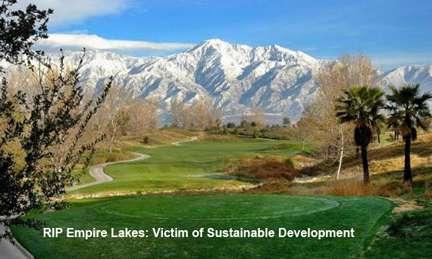Rancho Cucamonga Climate Action Plan (S/CAP)
Climate Action Plans are wrapped around ‘sustainability or sustainable development‘ (SD), which is basically lifestyle rationing scheme; plans essentially lower your standard of living in the name of climate change. The city of Rancho Cucamonga is heavily vested in centralized SD programs that promote high-density development, mass-transit, biking and walking over vehicle use. For example, there are proposals to tax people by the vehicle miles driven (VMT) and pricing for road use based on how congested roads are. Essentially, the government is commoditizing utilities and infrastructure in order to increase revenues – Why? Because they are broke.
12-16-2015: Sustainability ‘Workshop’
In a well-oiled presentation presented at a “workshop” by consultants and city staff on December 16th, 2015 at Rancho Cucamonga city hall, the city council voted unanimously to subject local citizens to a yearlong “process” to develop and implement for a Sustainability Vision and Climate Action Plan (S/CAP). The S/CAP is 100% voluntary; however, the council chose to circumvent voluntary provisions in the law based on rationalizations that the S/CAP grant of $150,000 from Southern California Association of Governments (SCAG) would beget more grants for the city in the future. The process evokes input from stakeholder groups. These groups form a Task Force:
“Approximately 20-25 members from local agencies, community organizations, and businesses will meet at various phases throughout the process. Task Force members serve a role in helping to develop the plan. Members will help to prioritize policies, programs, and other strategies to include in the S/CAP.”
Once the plan is basically developed, public outreach is solicited a highly-controlled dialectic process, whereby nonprofit corporations, government agencies and other “groups” reinforce predetermined outcomes offered by a trained facilitator.
“A Climate Action Plan (CAP) appears to be a Trojan horse that sets into motion Sustainable Community Strategy (SCS) parameters and reinforces these through continued solicitation of SCS grants. The plan is 100% voluntary; however, by approving a CAP, the city agrees to yet more state control, costs and regulation via follow ups for the CAP. For example, Green House Gas (GHG) inventories will be required every 5 years.
Builders already build to “green standards’, which makes much of a CAP unnecessary and redundant.
The city steps into the states sphere of influence by agreeing to a voluntary request. This dilutes our elected official’s authority as it is usurped, and in many cases abdicated away. This regional form of governance is not how our form of government, in a democratic republic, was designed to operate.
Our contention is that a CAP is voluntary. Therefore, there is really no problem to address.”
Documentation of Meeting
- Video of 12-16-2015 Meeting (about an hour).
- PowerPoint Presented by Consultant (This goes with video above)
- Sustainability programs in Rancho Cucamonga
- PowerPoint Text Only Outline
- Public Comment: Dan Titus (Dan reads this at the top of the video)
Timeline
- Public draft document of the S/CAP released on 2-6-2017: Public Comment Draft
- Here is the draft document.
- The public comment period ends on 2-24-2017
- The city council will vote on this on 3-15-2017
2. Dan Titus Notes: S/CAP project 2-18-2017
3. Foothill Tax Payers Association: Letter to city from Kassouni Law Offices 2-22-2017
4. Dan Titus comments 2-23-2017
5. The city council passed the S/CAP, 5-0 Link to Final Plan

